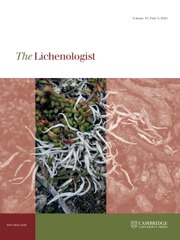No CrossRef data available.
Article contents
Genome-wide assessment of putative endemism and phylogeography of Cladonia sandstedei (Ascomycota: Cladoniaceae) in the Caribbean
Published online by Cambridge University Press: 12 December 2024
Abstract
Cladonia sandstedei forms cushion-shaped lichens that colonize open environments and is distributed throughout the Caribbean and the south-eastern United States. It co-occurs in parts of its range with C. subtenuis, a morphologically similar taxon that is distinguished from the former by the presence of usnic acid. Preliminary phylogenetic analysis with the RPB2 and TEF-1α loci revealed that these taxa were closely related, but relationships were inconsistent among markers. Here, we combined phylogenetic and population genomic analyses based on RADseq data to clarify the evolutionary relationships and phylogeography of these taxa. Both approaches indicate that the taxa cannot be separated based on secondary metabolites, as previously proposed, but instead form a complex composed of several lineages, largely unrelated to chemistry but with a strong geographical structure in their genetic variation. Continental populations formerly separated under the names C. sandstedei and C. subtenuis were closely related to each other. A similar pattern was observed in the Jamaican counterparts of these taxa, suggesting homoplasy of secondary chemistry. Discriminant Analysis of Principal Components (DAPC) hinted at potential conspecificity between populations in Cuba and Puerto Rico on one hand, and between Jamaica and the continental US on the other; however, phylogenetic analysis and other population-level analyses (PCA and fineRADstructure) suggested that both insular and continental populations were more likely to be reproductively isolated from each other. Based on this, we propose to recognize only one species for the entire complex, under the older name C. sandstedei, with the four spatially structured clades as subspecies: C. sandstedei subsp. sandstedei (restricted to Jamaica) and C. sandstedei subsp. subtenuis comb. nov. (restricted to continental North America) exhibit several chemosyndromes variably containing usnic acid and/or atranorin. The two additional subspecies described here as new, C. sandstedei subsp. cubana and C. sandstedei subsp. landroniana, exhibit the atranorin chemosyndrome and are restricted to Cuba and Puerto Rico, respectively. Our work reaffirms the power of combining RADseq-based phylogenetics and population genetics to disentangle taxonomic and evolutionary histories in poorly understood, closely related and phenotypically similar lichen-forming fungal species.
- Type
- Standard Paper
- Information
- The Lichenologist , Volume 56 , Special Issue 5: A Special Issue dedicated to Professor Teuvo Ahti , September 2024 , pp. 219 - 235
- Copyright
- Copyright © The Author(s), 2024. Published by Cambridge University Press on behalf of the British Lichen Society



